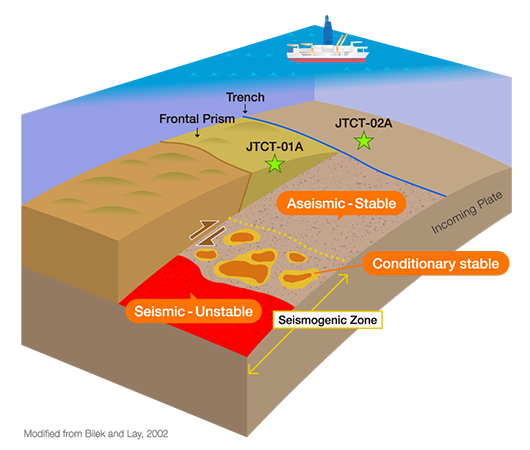
Goals of IODP3 Exp. 502E
IODP3 (Engineering) Expedition 502E aims to test key hypotheses about the long-term hydrogeologic and mechanical evolution of the Japan Trench megathrust by redeploying temperature sensor strings in observatory Holes C0019D and C0019Q and conducting surveys of downhole deformation.
Specifically, we hypothesize that permeability within the fault damage zone remains elevated relative to the plate boundary fault core and that hydrogeologic properties continue to evolve due to healing processes. Redeployed temperature sensors will allow us to assess changes over time by capturing thermal anomalies associated with fluid migration and hydrogeologic transients. We further hypothesize that horizontal fluid flow past the borehole varies with depth, reflecting structural heterogeneities within the fault zone.
A Thermal Response Test will quantify background flow rates past the borehole casing, providing direct constraints on lateral fluid migration and its role in pressure redistribution. These data will be integrated with geochemical observations and temperature time-series analysis to assess the role of fluids in modulating fault strength.

Scientific Objectives
Findings from JFAST
During IODP Exp. 343 JFAST in 2012, we recovered a portion of the plate boundary materials and revealed that the very low shear stress can be attributed to the abundance of weak clay (smectite) and thermal pressurization effects, which can facilitate fault slip. Analysis of borehole breakouts revealed that the stress state one year after the Tohoku-oki earthquake was in a normal faulting regime consistent with coseismic fault weakening and nearly total stress drop. Temperature data from the observatory recovered the frictional heat signature of the 2011 Tohoku-oki earthquake indicating low coseismic friction.
Goals of JTRACK
However, some questions still remain: 1) What are the dominant fault zone structures, rock physical properties, and deformation and healing properties that control slip? 2) What is the current stress state in the rocks surrounding the fault zone? 3) How does fluid flow contribute to the stress state and mechanical behavior of the décollement?
To answer these questions, IODP Exp. 405 plans to undertake a complete transect of the frontal prism and decollement in the zone of large slip, and undeformed materials on the incoming plate, collecting core samples, LWD, and observatory data.


- Characterize the geologic composition and structure of the frontal prism, décollement, and subducted oceanic crust to determine how these materials and structures control fault mechanics or reveal evidence of past earthquakes and deformation.

- Characterize the stress state within and around the fault zone that experienced large coseismic slip during the 2011 Tohoku-oki earthquake.

- Characterize the hydrogeology of the plate boundary fault zone and frontal prism.






















